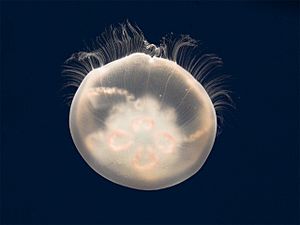Radiata facts for kids
Quick facts for kids RadiataTemporal range: Ediacaran – Recent
|
|
|---|---|
 |
|
| A moon jellyfish, Aurelia aurita | |
| Scientific classification | |
| Kingdom: | |
| Subkingdom: | |
| (unranked): |
Radiata
Linnaeus, 1758
|
| Phyla | |
|
|
The Radiata is a group of animals that scientists used to think were closely related. It includes animals like jellyfish and comb jellies. The name "Radiata" comes from the word "radial," which describes their body shape. Imagine a pizza or a bicycle wheel; they have parts arranged around a central point. This is called radial symmetry.
However, this group is not part of the main way scientists classify animals today. Most biologists do not use the term "Radiata" anymore. This is because newer research shows that the animals once grouped as Radiata are not as closely related as once thought.
Contents
What is Radial Symmetry?
Animals with radial symmetry have body parts arranged around a central axis. This means you can cut them into several equal halves through the center, like slicing a pie. Think of a starfish or a sea anemone.
Animals like humans have bilateral symmetry. This means you can only cut them into two equal halves (left and right) down the middle.
Animals in the Radiata Group
The Radiata group mainly included two phyla (major animal groups):
- Cnidaria: This phylum includes jellyfish, sea anemones, corals, and hydras. Most cnidarians show radial symmetry.
- Ctenophora: These are comb jellies. They look a bit like jellyfish but are different. They have a special type of radial symmetry called biradial symmetry.
Some older ideas about Radiata also included sponges (Porifera) and other simple animals. However, these ideas are not widely accepted today.
Why Scientists Changed Their Minds
Scientists use cladistics to study how living things are related. They look at shared features and DNA to build "family trees" of life. When they did this for the Radiata, they found that the animals in this group did not all share a common ancestor that wasn't also an ancestor to other animal groups. This means Radiata is not a true "clade" (a group of organisms that includes a common ancestor and all its descendants).
Also, scientists learned more about how symmetry developed in animals:
- Even though jellyfish look radially symmetrical, their young forms (called planula larvae) actually show bilateral symmetry.
- Newer studies suggest that bilateral symmetry might have appeared very early in animal evolution. This means that some animals, like jellyfish, might have evolved radial symmetry after their ancestors had bilateral symmetry. It's like they went back to a simpler body plan.
So, while the idea of Radiata helped scientists understand animal diversity in the past, modern research has given us a clearer picture of how animals are related.
See also
 In Spanish: Radiata para niños
In Spanish: Radiata para niños

